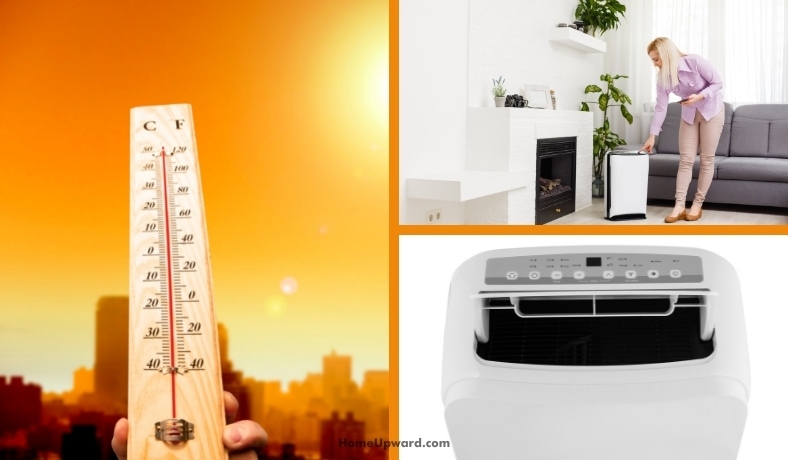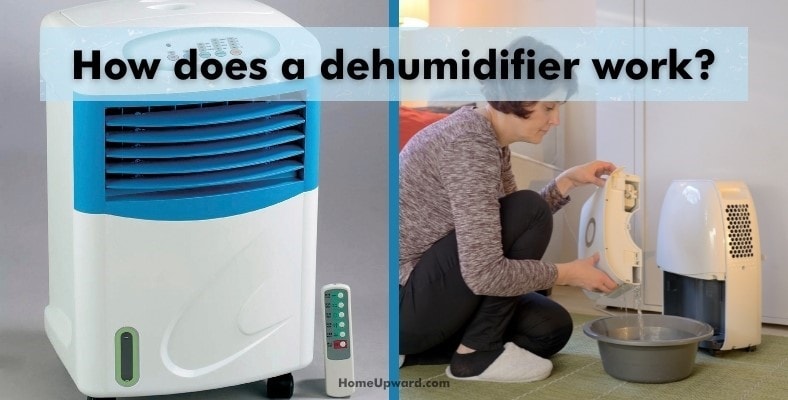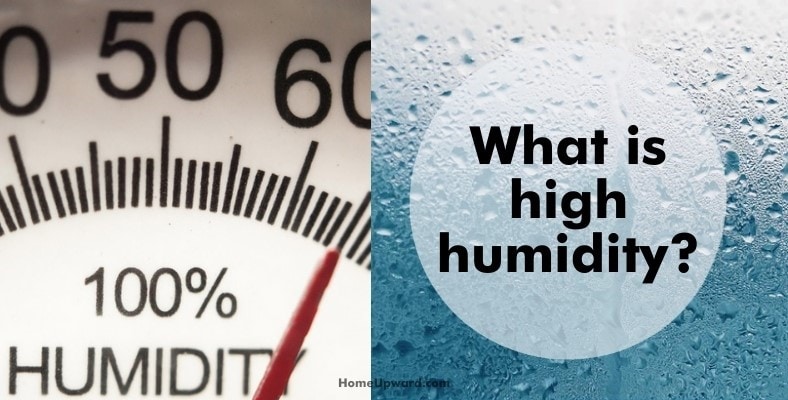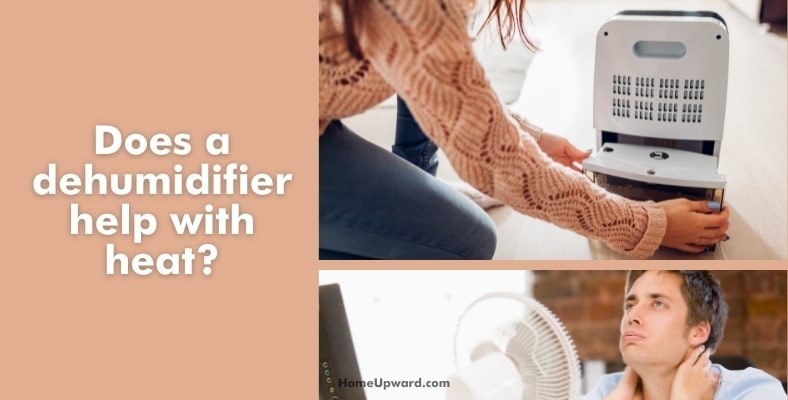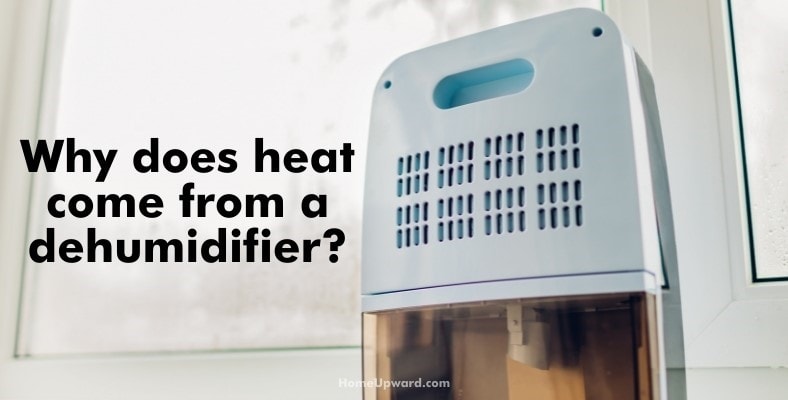Dehumidifiers can be a real lifesaver. Whether you live in the South and the heat is too much, or you live in New York during the humid season, a dehumidifier can help you make your home bearable.
We all know dehumidifiers take moisture out of the air but does a dehumidifier help with heat? Let’s dig in and I’ll share all the facts you need.
Contents
How does a dehumidifier work?
As an overview, dehumidifiers work by sucking in humid air, taking the moisture out of the air, and then sending back the dry air into your home. Usually, the moisture it takes out of the air is either sent out of a hose near the rear of the unit or held in its internal tank.
There are multiple types of dehumidifiers. The two most common are the heat pump or chemical absorbent dehumidifiers.
Heat Pump Dehumidifier
The most common type of dehumidifier in people’s homes is a heat pump dehumidifier. Most air conditioning units have a heat pump, but they also have other components designed to cool the air. In contrast, dehumidifiers of this variety only have a heat pump.
A heat pump dehumidifier works by sucking air from inside your home into the dehumidifier using fans. The dehumidifier then passes the humid air over cooling coils that are almost at freezing temperatures. These coils cool the air, allowing the moisture to condense and turn from a gas to a liquid.
The air then runs over another set of coils, but they’re warm rather than cold this time. The warm coils heat the dry air back up, which helps the air lose even more humidity. The warm air is then pumped into your room using the fans on the dehumidifier.
Chemical Absorbent Dehumidifier
Chemical absorbent dehumidifiers use a ‘desiccant,’ a chemical compound that absorbs any moisture it comes into contact with, whether the moisture is a liquid or a vapor. The most common household desiccant is silica, the tiny beads often found in packages. In chemical absorbent dehumidifiers, they use much more powerful desiccants.
Chemical absorbent dehumidifiers use a lot more energy than heat pump dehumidifiers, which is why they are a less common variety. The only way it’s cost-efficient is if it uses natural gas as heat exchange gas. Otherwise, the electricity costs would be too high.
As you can probably guess, construction or industrial settings are the most common places that use chemical absorbent dehumidifiers. These workplaces often need the dehumidifying effects more than they worry about the costs.
What is high humidity?
We usually represent humidity as a percentage. We call this percentage ‘relative humidity,’ which is the standard way to measure humidity. The relative humidity is a measurement of how much moisture is in the air as a percentage of the maximum humidity that could be in the air at a given temperature.
So how much humidity is too much? Humidity becomes more noticeable as temperatures rise, so what might be acceptable at 60º will be too hot at 90º. As a rule of thumb, once humidity levels reach 65% inside your home, you’ll start feeling the effects of high humidity.
Does a dehumidifier help with heat?
As you can probably tell by our explanation of how a dehumidifier works, dehumidifiers don’t cool down your house directly. In fact, they slightly increase your home’s temperature by sending out warm air from their internal workings. But how much does a dehumidifier help with heat?
But that’s not the whole story. Humidity can make you feel warmer than almost any amount of heat. Just think, summer temperatures are usually higher in Arizona than in Florida, yet many people complain about the temperatures in the Sunshine State. Why is that?
Humidity makes people feel hot because it inhibits our natural cooling process. People cool themselves by sweating. Sweat escapes from our pores and interacts with the air around us. When sweat comes into contact with the air, it begins to evaporate. The evaporation process cools us down.
When humidity is too high, the sweat on your skin won’t evaporate, causing you to feel warmer. Your sweat won’t evaporate because the moisture in the air is already too high. Therefore, the moisture in your sweat will stay on your skin, causing you to feel even warmer.
By using a dehumidifier, you can help your body cool itself more naturally. By reducing the amount of humidity in your home, your sweat will evaporate naturally. Although a dehumidifier won’t cool down your home, you’ll know it is working as you become comfortable and will notice a reduction in humidity.
How much heat does a dehumidifier produce?
You could run a powerful dehumidifier for hours inside your home without noticing the amount of heat it’s producing. That normally occurs because of the drop in humidity. Once the humidity falls, you’ll begin to feel cooler even if the air temperature remains stable or increases slightly.
On average, a dehumidifier will increase the air temperature by only a few degrees for every kilowatt-hour (kWh) of electricity you use. A dehumidifier will capture roughly four pints of water for every kWh of electricity.
That means you’ll be using your dehumidifier for hours before you notice any increase in temperature. By that point, your dehumidifier will take enough moisture out of the air for you to feel comfortable with the minor rise in temperature.
Why does heat come from a dehumidifier?
A dehumidifier produces heat as a natural consequence of cooling and condensing the moisture in the air. After the air cools down, the dehumidifier needs to reheat the air to get it to your desired relative humidity.
On all dehumidifiers, you can choose what humidity level you’d like your home to remain. To get the humidity levels to that amount, the dehumidifier reheats the air after cooling. The reheating process turns the remaining humidity in the air into steam, thus lowering the humidity.
By heating the air, the dehumidifier can work much more efficiently. If the dehumidifier just cooled the air to get to the lower humidity levels, it would use a lot more energy. By warming up the air and allowing the steam to dissipate naturally, your dehumidifier uses less energy.
The obvious consequence of this is an increase in air temperatures. But then again, if you’re looking to pump cool air into your home, you’d be in the market for an air conditioner, not a dehumidifier.
How cold will a dehumidifier cool a room?
A dehumidifier will not make a room cool, but it can help the room feel more comfortable. Let’s give an example to show you how a dehumidifier makes a room more comfortable.
If it’s 90ºF with 65% humidity, the temperature will feel more like 102ºF. In contrast, a 90ºF room with 30% actually feels like 90ºF. If you want to see some more humidity calculations, you can use this handy heat index from the National Weather Service.
As you can see, humidity plays an immense role in how warm the air feels. As you lower the humidity in a room, the temperature will also feel like it’s going down because your body can control its temperature better.

